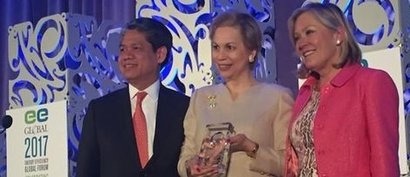
In partnership with The Climate Group, the Alliance also announced that two new companies – H&M, the multinational clothing retail company, and Cree, the US-based LED lighting and technology company – are joining EP100, the global initiative of leading businesses pledging to double their energy productivity.
EE Global, the world’s premier energy efficiency forum, drew more than 400 industry leaders from nearly 30 countries around the world.
The Alliance worked with more than 50 companies and organizations to develop the systems efficiency blueprint, which is accompanied by a call to action for buildings sector stakeholders to collaborate in the goal of achieving the next level of efficiency in buildings. It is the second report of the Alliance’s Systems Efficiency Initiative (SEI), which seeks to capitalise on new technologies allowing smarter interactions of components within and among various building systems, as well as interactions among multiple buildings, and between the building and the electric grid.
“We’ve known for years that while we need to continue making progress on the efficiency of individual components in buildings, we can’t meet our goals without also looking at buildings holistically and taking a systems approach” said Alliance President Kateri Callahan said of the systems efficiency report. “It’s time we move from the discussion phase to execution, and that’s what this blueprint is intended to do.”
Jenny Chu, Head of Energy Productivity Initiatives at The Climate Group, added that H&M and Cree have been taking bold steps on energy productivity and that The Climate Group is delighted to welcome them to EP100 and showcase their climate leadership. Business accounts for about half of the electricity used worldwide and by focusing on energy productivity outcomes, companies like H&M and Cree can demonstrate that corporates can reduce their own energy demand, improve their bottom lines and contribute to the implementation of the Paris Agreement.
The publication is a follow-up to the 2016 SEI report, Greater Than the Sum of its Parts: The Case for a Systems Approach to Energy Efficiency.
The blueprint offers a broad range of actions designed to optimize building performance and achieve other benefits, such as improved resilience. It includes 84 specific recommendations for Congress, federal agencies, state and local governments, utilities, and building professionals. The recommendations address opportunities to improve the efficiency of key building systems (e.g., lighting, hot water, miscellaneous electric loads) and their interactions, as well as to achieve efficiency gains through direct-current power distribution, grid integration, combined heat and power, and district energy systems.
Cree and H&M are the latest companies to join EP100, which encourages influential businesses to double their energy productivity as part of international efforts to transition to a net-zero economy. By doubling the economic output from every unit of energy consumed, companies set a bold target demonstrating clean energy leadership while reaping the benefits of lower energy costs and increased competitiveness.
On joining the campaign, Greg Merritt, Cree vice president of marketing and public affairs, said that joining EP100 was a natural [decision] for the company, as improving energy productivity is the essence of what Cree does. The company’s constant innovations in LED, LED lighting and other technologies enable people to do more and consume less.
Image: Alliance to Save Energy
For additional information:
Going Beyond Zero: A Systems Efficiency Blueprint for Building Energy Optimization and Resilience

